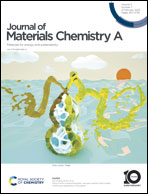Polyiodide shuttle inhibition in ethylene glycol-added aqueous electrolytes for high energy and long-term cyclability of zinc–iodine batteries†
Abstract
Developing high-performance cathode materials matchable with zinc anodes is critical for the practical application of aqueous Zn metal batteries. Although cathodes based on iodine conversion chemistry are appealing owing to the high theoretical capacity and ideal redox potential of the I2/I− redox couple compatible with water, they suffer from low coulombic efficiency and poor cycling stability because of the inevitable shuttle of polyiodides toward the Zn anodes and associated side reactions. Herein, high-density ordered porous graphene (HOPG) is utilized as the iodine host cathode in a ZnI2-containing aqueous electrolyte, achieving a high volumetric capacity of 388.8 mA h cm−3 at 1 A−1. Moreover, the shuttle of polyiodides and the side reactions on Zn anodes can be inhibited by adding ethylene glycol (EG) to the aqueous electrolyte, attributed to the complexation of EG with polyiodides and altered Zn2+ solvation structure. Consequently, the Zn–I2 battery exhibits a high energy density of 334.3 W h L−1 at 1.5 kW L−1 (based on the HOPG volume) and excellent cycling stability of 15 000 cycles with 97.6% capacity retention.



 Please wait while we load your content...
Please wait while we load your content...